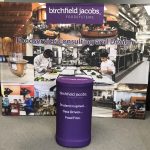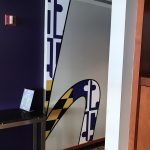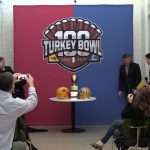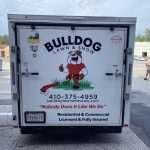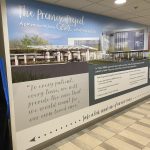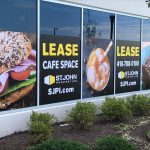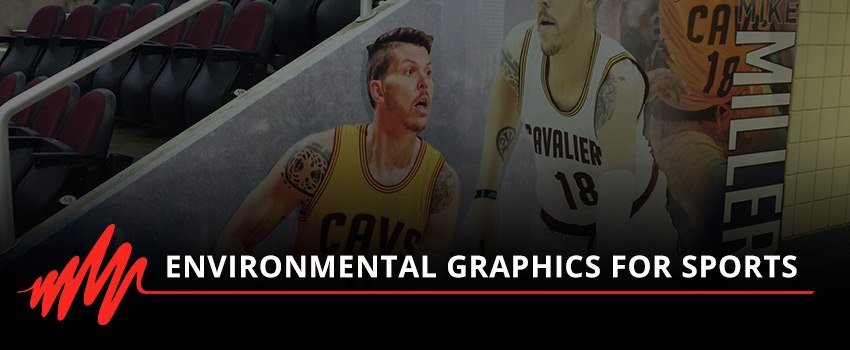
Environmental Graphics For Sports
APRIL 19, 2019| SpeedPro TowsonCategories
UncategorizedWhen you arrive at a stadium for a game, how do you know how to get to your seat, find the bathroom and, most importantly, locate the concessions area? Many sports stadiums are designed with enough space for thousands if not tens of thousands of people — the biggest stadium in the US, the Michigan Stadium, has room for more than 107,000 people. With so many people milling about before and during games, it’s essential that everyone knows where to go and how to get there.
Environmental graphics help anyone who goes to a stadium find their way about. Environmental graphics in sports not only help you find your seat or a snack, but they can also help to set the mood of a sporting event and make you feel excited to be there and support your team. Thanks to environmental graphic design, every stadium in the world can be a truly unique place.
WHAT IS ENVIRONMENTAL GRAPHIC DESIGN?
Admittedly, environmental graphic design isn’t something the average person knows about. However, most people would notice if it weren’t around. Environmental graphics are what give a space, such as a stadium, its zing and pop. They’re a mixture of form and function, as they enliven a space and help people get where they need to go.
The official definition of environmental graphic design comes from the Society of Experiential Graphic Design (SEGD, formerly known as the Society for Environmental Graphic Design): “Environmental Graphic Design (EGD) embraces many design disciplines including graphic, architectural, interior, landscape, and industrial design, all concerned with the visual aspects of wayfinding, communicating identity and information, and shaping the idea of creating experiences that connect people to place.”

Although the idea of using stories and signs to help guide people through an environment is probably as old as humankind itself, the notion of “environmental graphic design” as a practice and profession is only about four decades old. According to the SEGD, the idea of environmental graphic design has evolved in recent years. At the start of the practice, the big concern might have been wayfinding, using graphics and signs to guide people through a space. But EGD has become much more than wayfinding.
These days, environmental (or experiential) graphic design not only guides people through a stadium or other area but also helps to create and define their experience in a space. Elements of environmental graphic design work hand-in-hand with the built environment, such as a stadium. The SEGD has divided environmental graphic design into multiple practice areas, all of which can work together.
PRACTICE AREAS FOR ENVIRONMENTAL GRAPHICS
If you’re thinking of incorporating environmental graphics in your sports arena, consider the following applications:
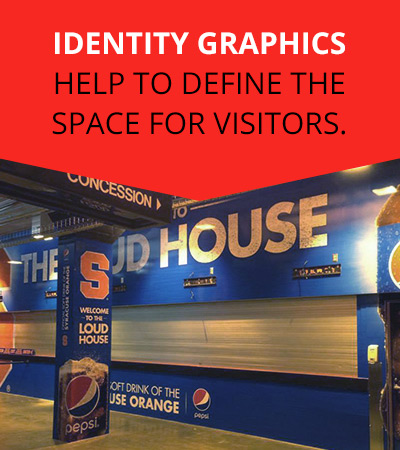
- Wayfinding: People want to be able to get from point A to point B with as little friction as possible. They don’t want to have to think about walking 100 meters, turning left or right, and so on. Wayfinding in environmental design gives people the right amount of information at the exact moment they need it. It doesn’t provide more details than is necessary. It also helps people orient themselves in an unfamiliar space (think “you are here” markers on a map at a mall or stadium).
- Identity graphics: Identity graphics help to define the space for visitors. Also known as placemaking, in a sports setting, these graphics can make use of a team’s colors, mascot or other defining characteristics to remind people of where they are and what they’re doing there.
- Themed or branded environments: Environmental graphic design also plays a role in creating a themed environment, or an atmosphere that fits in with a brand’s overall identity. In the case of sports stadiums, branded or themed design can involve incorporating the logos and details of the stadium’s sponsors into the overall design of the space. It can also mean finding ways to recreate an experience that’s relevant to a team’s brand within the stadium itself.
- Installations: Installations in environmental graphic design often fall into one of several categories. They can include public art installations, such as major memorials in big cities, as well as installations in a retail environment, such as interactive fit guides in a clothing store or large works of art in corporate offices. Ideally, the installation should capture the mood of the space. For example, a public memorial should give people the chance to pause and reflect. A retail installation should echo the style of the store it’s located in.
- Exhibitions: Whether permanent or traveling, exhibitions at museums and galleries are considered part of environmental graphic design. A well-designed exhibition should move you through the space with ease, providing information to you at the appropriate moments. Although there’s usually a flow of traffic through an exhibition space, visitors of an exhibit shouldn’t feel confused or lost if they jump from one area to another out of order.
COMPONENTS OF ENVIRONMENTAL GRAPHIC DESIGN
These graphics can take various forms and incorporate different elements, including:
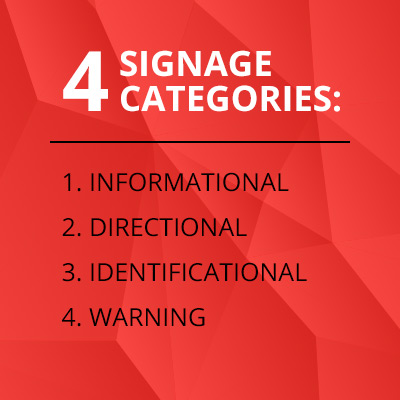
- Signage: Without signage, people wouldn’t know where to go, whether they’re in a sports stadium, navigating their way through an airport or trying to find their way in an unfamiliar city. Signage also helps people to understand what they’re looking at or experiencing at an exhibition or installation. Signage falls into four categories: Informational (“You Are Here”), Directional (“Turn Left”), Identificational (“Restroom”) and Warning (“No Smoking,” “Employees Only”).
- Pictograms: The information displayed on the signs is another component of environmental design. Pictograms, or symbols, help to make signs understandable no matter what language a person speaks. An arrow pointing left or right means the same thing in every language, as does a picture of a cigarette with a line through it. Pictograms also help to save space and effort.
- Fonts: Also known as typography, the fonts used in environmental graphic design can make or break a sign. For example, you pretty much never see cursive or script fonts used on signs. They’re difficult to read, for one thing. The size of the typeface and whether or not it’s serif or sans serif also matters. One of the most popular fonts or typefaces out there is Arial, which is sans serif and tends to pop up all over the place.
- Colors: Color is also a component of environmental graphic design. The colors a designer uses and how those colors work together (or not) can influence how easy it for a person to navigate through a space and can also change their mood. For example, McDonald’s used to primarily use red and yellow in its designs and at its restaurants, as the two colors are thought to make people hurry up and eat. As the brand has shifted to focus on “healthier” options, it’s introduced more colors to its palette, including green, which is often thought of as the be-all, end-all healthy color.
- Digital technology: There’s been a shift from straight up print design to digital design in recent years. Digital technology makes it easier to change different aspects of environmental design, as the use of a space changes. For example, it’s easy to switch digital signage when a stadium is used by both a football and baseball team or when a stadium is used for sports and entertainment events. Digital technology includes LCD and LED signs as well as holograms and virtual reality.
HOW TO USE ENVIRONMENTAL GRAPHICS IN SPORTS
When fans head to their local stadium to see their team play, their experience of the game starts well before they get to the parking lot. Sports fans are likely to dress up in the colors and jerseys of their team. The most dedicated followers will have other accessories — such as hats and blankets — with the team’s logo. It makes sense for a stadium to capture that enthusiasm and infuse the team’s identity into the environmental design of the space. This process starts with the components and practices of environmental design.
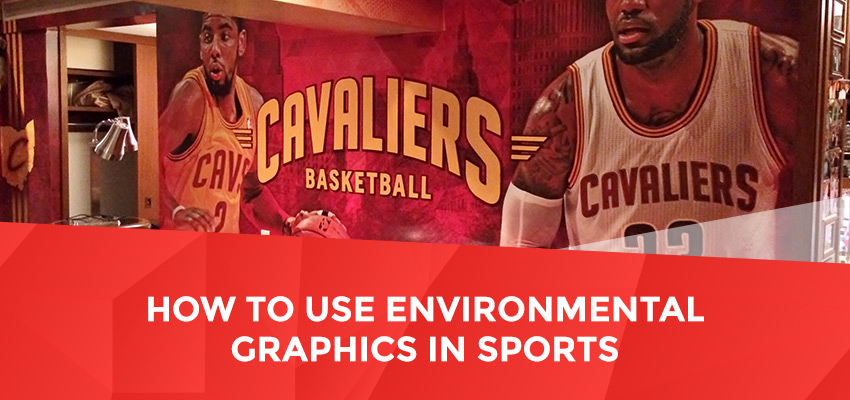
Let’s create a hypothetical sports team and stadium and show how it can use environmental graphics. The team is the Pennsylvania Bald Eagles. The team’s mascot is a bald eagle, and its colors are brown, blue and white. The Bald Eagles play baseball and share their stadium with a Pennsylvania football team.
The owners of the team and the managers of the stadium want fans to feel at home the minute they pull into the parking lot. The parking lines on the surface of the lot are painted a blue that matches the team’s blue. Pictograms that look like eagle’s beaks or talons help drivers navigate their way through the lot to an empty parking space. Parking lot attendants wear PA Bald Eagles hats and jackets as they help people find a spot for their cars.
As people walk up to the doors of the stadium, digital signs direct them to the appropriate door based on their ticket level and type. Along with arrows showing people where to go, there are pictures of eagles on the signs. The typography of the signs uses the same blue that’s found in the parking lot.
Now, people are inside the stadium. White-background signs with brown typeface and blue pictograms direct people to restrooms, food courts and seating. On the walls that line the corridors of the stadium are large murals showing pictures of famous Pennsylvania Bald Eagles, both past and present. Since the Bald Eagles are a state team, a few small exhibitions are set up throughout the corridors and waiting areas of the stadium. These exhibitions detail the history of the state, provide information about bald eagles and explain why the team is named for them and not the state bird, the ruffed grouse.
As fans make their way to their seats, it’s easy for them to find where they’re going. Seating areas are clearly labeled, and maps placed throughout the stadium’s walkways help people head in the right direction. A fan who wants to make a detour to the concession area or restroom can do so easily without getting lost.
The Pennsylvania Bald Eagles aren’t afraid of technology and have found ways to integrate digital signage and other tech into the stadium’s environmental design. Holograms of current players are set up throughout the waiting area. The holograms are motion-activated and start talking about the player’s stats, history or why they love baseball when people walk by. On the field, LCD screens display pictures of players as they’re called up to bat. Overlaid on top of the images are the players’ current stats for the season.
Because of the environmental graphics, fans who get to go to a Bald Eagles baseball game aren’t just going to a ball game. They’re getting fully immersed in the world of the Bald Eagles, an experience they can’t replicate by watching the game at home.
EXAMPLES OF THE BEST ENVIRONMENTAL GRAPHIC DESIGN AT SPORTS STADIUMS
Now that we’ve created a hypothetical stadium to show how environmental graphic design can be used, let’s look at a few real-life examples of the best graphics for sports stadiums.
- Parc Olympique, Montreal, Quebec: Parc Olympique was constructed in Montreal for the 1976 Olympic games. In honor of its 40th anniversary in 2016, the sports complex underwent a makeover that included updates to its environmental design. Among those updates was the addition of themed stations that provide visitors with details and information about the complex’s history and the use of a logo made up of four concentric circles. The logo not only helped to tie the design elements of the sports complex together, but it also created a retro look, appropriate for a center that was first used in the 1970s.
- Titletown, Green Bay, Wisconsin: Titletown is the name of a civic park located next to the stadium where the Green Bay Packers play. The name of the park comes from the fact that the Packers have won the most football world championships of any team. Green and gold, the Packers’ colors, appear throughout the park, as does “TT,” the logo of the park. Wayfinding signs use the logo and colors to help visitors get around the park with ease.
- Minnesota Vikings/US Bank Stadium: Although the Minnesota Vikings aren’t the only tenant to call the US Bank Stadium home, they’re the tenant that foots most of the bills. For that reason, the design of the stadium has incorporated Viking branding throughout. Examples of branding include a timeline of the team’s history found in the stadium’s concourse and banners featuring current and past players. A digital display on the exterior of the stadium highlights the team and its opponents during home games.
- University of Oklahoma Barry Switzer Center: Designed for student-athletes at the University of Oklahoma, the Barry Switzer Center successfully incorporates branding and themes into its designs. In the locker room, players each get their own locker, complete with a sign that includes a picture and lists their name, position and hometown. The OU logo is found throughout the player’s football lounge, as are small details that recall the team’s history, such as championship rings and trophies.
From murals to wayfinding signage to event graphics to digital signage, SpeedPro offers a range of services that can be worked into the environmental graphic design of a stadium or sports complex. To learn more about our products and services and how we can help you create an immersive experience for fans and players alike, contact us today.



